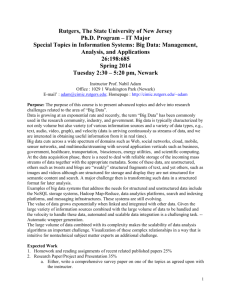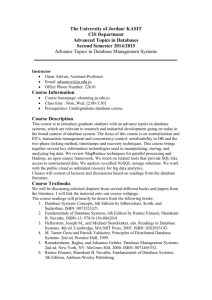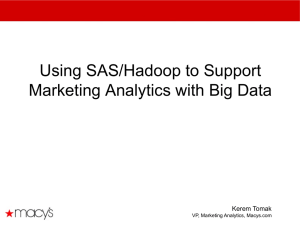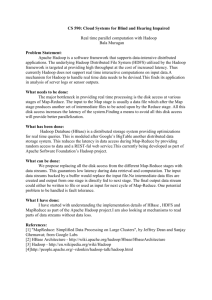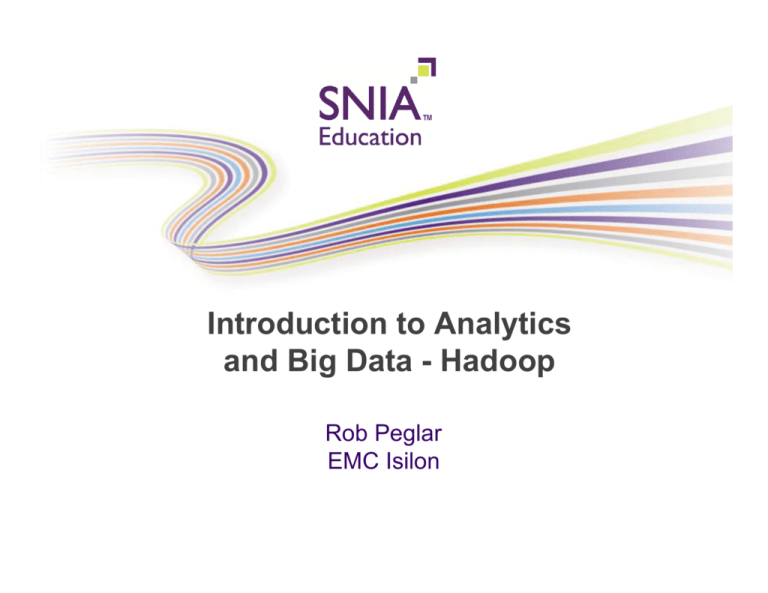
PRESENTATION TITLE
HERE
Introduction
toGOES
Analytics
and Big Data - Hadoop
Rob Peglar
EMC Isilon
SNIA Legal Notice
The material contained in this tutorial is copyrighted by the SNIA unless
otherwise noted.
Member companies and individual members may use this material in
presentations and literature under the following conditions:
Any slide or slides used must be reproduced in their entirety without modification
The SNIA must be acknowledged as the source of any material used in the body of
any document containing material from these presentations.
This presentation is a project of the SNIA Education Committee.
Neither the author nor the presenter is an attorney and nothing in this
presentation is intended to be, or should be construed as legal advice or an
opinion of counsel. If you need legal advice or a legal opinion please
contact your attorney.
The information presented herein represents the author's personal opinion
and current understanding of the relevant issues involved. The author, the
presenter, and the SNIA do not assume any responsibility or liability for
damages arising out of any reliance on or use of this information.
NO WARRANTIES, EXPRESS OR IMPLIED. USE AT YOUR OWN RISK.
Introduction to Analytics & Big Data – Hadoop
© 2013 Storage Networking Industry Association. All Rights Reserved.
2
BIG DATA AND HADOOP
Data Challenges
Why Hadoop
Introduction to Analytics & Big Data – Hadoop
© 2013 Storage Networking Industry Association. All Rights Reserved.
Customer Challenges: The Data Deluge
IN 2010 THE DIGITAL UNIVERSE WAS
1.2 ZETTABYTES
IN A DECADE THE DIGITAL UNIVERSE WILL BE
35 ZETTABYTES
90% OF THE DIGITAL UNIVERSE IS
UNSTRUCTURED
IN 2011 THE DIGITAL UNIVERSE IS
300 QUADRILLION FILES
The Economist, Feb 25, 2010
Introduction to Analytics & Big Data – Hadoop
© 2013 Storage Networking Industry Association. All Rights Reserved.
4
Big Data Is Different than Business Intelligence
“TRADITIONAL BI”
“BIG DATA ANALYTICS”
Repetitive
Experimental, Ad Hoc
Structured
Mostly Semi-Structured
Operational
External + Operational
GBs to 10s of TBs
10s of TB to 100’s of PB’s
Introduction to Analytics & Big Data – Hadoop
© 2013 Storage Networking Industry Association. All Rights Reserved.
5
Questions from Businesses will Vary
Past
Future
What
happened?
What is happening?
What is likely to happen?
Reporting, Dashboards
Real‐Time
Analytics
Predictive
Analytics
Why did it happen?
Why is it happening?
What should I do about it?
Forensics & Data Mining
Real‐Time
Data Mining
Prescriptive
Analytics
Introduction to Analytics & Big Data – Hadoop
© 2013 Storage Networking Industry Association. All Rights Reserved.
6
Web 2.0 is “Data-Driven”
“The future is here, it’s just not evenly distributed yet.”
William Gibson
Introduction to Analytics & Big Data – Hadoop
© 2013 Storage Networking Industry Association. All Rights Reserved.
7
The world of Data-Driven Applications
Introduction to Analytics & Big Data – Hadoop
© 2013 Storage Networking Industry Association. All Rights Reserved.
8
Attributes of Big Data
Volume
Terabytes
Transactions
Tables
Records
Files
Batch
Near Time
Real Time
Streams
Velocity
Structured
Unstructured
Semistructured
Variety
Introduction to Analytics & Big Data – Hadoop
© 2013 Storage Networking Industry Association. All Rights Reserved.
9
Ten Use Cases for Big Data Analytics
1. Modeling true risk
2. Customer churn
analysis
3. Recommendation
engine
4. Ad targeting
5. PoS transaction
analysis
6. Analyzing network
data to predict
failure
7. Threat analysis
8. Trade surveillance
9. Search quality
10.Data “sandbox”
Introduction to Analytics & Big Data – Hadoop
© 2013 Storage Networking Industry Association. All Rights Reserved.
10
The Big Data Opportunity
Financial Services
Healthcare/Scientific
Retail
Web/Social/Mobile
Manufacturing
Government
Introduction to Analytics & Big Data – Hadoop
© 2013 Storage Networking Industry Association. All Rights Reserved.
11
Industries Are Embracing Big Data
Retail
Advertising & Public Relations
• CRM – Customer Scoring
• Store Siting and Layout
• Fraud Detection / Prevention
• Supply Chain Optimization
• Demand Signaling
• Ad Targeting
• Sentiment Analysis
• Customer Acquisition
Financial Services
Media & Telecommunications
• Algorithmic Trading
• Risk Analysis
• Fraud Detection
• Portfolio Analysis
• Network Optimization
• Customer Scoring
• Churn Prevention
• Fraud Prevention
Manufacturing
Energy
• Product Research
• Engineering Analytics
• Process & Quality Analysis
• Distribution Optimization
• Smart Grid
• Exploration
Government
Healthcare & Life Sciences
• Market Governance
• Counter-Terrorism
• Econometrics
• Health Informatics
• Pharmaco-Genomics
• Bio-Informatics
• Pharmaceutical Research
• Clinical Outcomes Research
Introduction to Analytics & Big Data – Hadoop
© 2013 Storage Networking Industry Association. All Rights Reserved.
12
Why Hadoop?
Answer: Big Datasets!
Introduction to Analytics & Big Data – Hadoop
© 2013 Storage Networking Industry Association. All Rights Reserved.
13
Why Hadoop?
Big Data analytics and the Apache Hadoop open
source project are rapidly emerging as the preferred
solution to address business and technology trends
that are disrupting traditional data management and
processing.
Enterprises can gain a competitive advantage by
being early adopters of big data analytics.
Introduction to Analytics & Big Data – Hadoop
© 2013 Storage Networking Industry Association. All Rights Reserved.
14
Storage & Memory B/W lagging CPU
Annual bandwidth improvement (all milestones)
Annual latency improvement (all milestones)
CPU
DRAM
LAN
Disk
1.5
1.27
1.39
1.28
1.17
1.07
1.12
1.11
Memory Wall
Storage Chasm
CPU B/W requirements out-pacing memory and storage
Disk & memory getting “further” away from CPU
Large sequential transfers better for both memory & disk
Introduction to Analytics & Big Data – Hadoop
© 2013 Storage Networking Industry Association. All Rights Reserved.
15
Commodity Hardware Economics
For $1000
One computer can
Process
~32GB
Store
99.9%
~15TB
Of data is Underutilized
Introduction to Analytics & Big Data – Hadoop
© 2013 Storage Networking Industry Association. All Rights Reserved.
16
Enterprise + Big Data = Big Opportunity
Introduction to Analytics & Big Data – Hadoop
© 2013 Storage Networking Industry Association. All Rights Reserved.
17
WHAT IS HADOOP
Hadoop Adoption
HDFS
MapReduce
Ecosystem Projects
Introduction to Analytics & Big Data – Hadoop
© 2013 Storage Networking Industry Association. All Rights Reserved.
Hadoop Adoption in the Industry
2007
2008
2009
2010
The Datagraph Blog
Introduction
to Analytics & Big Data – Hadoop
Source: Hadoop Summit Presentations
© 2013 Storage Networking Industry Association. All Rights Reserved.
19
What is Hadoop?
A scalable fault-tolerant distributed system for data storage
and processing
Core Hadoop has two main components
Hadoop Distributed File System (HDFS): self-healing, highbandwidth clustered storage
Reliable, redundant, distributed file system optimized for large files
MapReduce: fault-tolerant distributed processing
Programming model for processing sets of data
Mapping inputs to outputs and reducing the output of multiple Mappers to one (or
a few) answer(s)
Operates on unstructured and structured data
A large and active ecosystem
Open source under the friendly Apache License
http://wiki.apache.org/hadoop/
Introduction to Analytics & Big Data – Hadoop
© 2013 Storage Networking Industry Association. All Rights Reserved.
20
HDFS 101
The Data Set System
Introduction to Analytics & Big Data – Hadoop
© 2013 Storage Networking Industry Association. All Rights Reserved.
21
HDFS Concepts
Sits on top of a native (ext3, xfs, etc..) file system
Performs best with a ‘modest’ number of large files
Files in HDFS are ‘write once’
HDFS is optimized for large, streaming reads of files
Some implementations treat HDFS as a ‘protocol’
Introduction to Analytics & Big Data – Hadoop
© 2013 Storage Networking Industry Association. All Rights Reserved.
22
HDFS
Hadoop Distributed File System
–
–
–
–
–
Data is organized into files & directories
Files are divided into blocks, distributed across cluster nodes
Block placement known at runtime by map-reduce = computation
co-located with data
Blocks replicated to handle failure
Checksums used to ensure data integrity
Replication: one and only strategy for error handling,
recovery and fault tolerance
–
–
Self Healing
Make multiple copies
Introduction to Analytics & Big Data – Hadoop
© 2013 Storage Networking Industry Association. All Rights Reserved.
23
Hadoop Server Roles
Client
Client
Name
Node
Job
Tracker
Master
Data
Node
Task
Tracker
Client
Client
Task
Tracker
Slave
Client
Client
Client
Secondary
Node
Master
Data
Node
Slave
Data
Node
Client
Task Tracker
Data
Node
Slave
Slave
Data
Node
Task Tracker
Slave
Task
Tracker
Data
Node
Up to 4K
Nodes
Task Tracker
Slave
Introduction to Analytics & Big Data – Hadoop
© 2013 Storage Networking Industry Association. All Rights Reserved.
24
Hadoop Cluster
CORE SWITCH
CORE SWITCH
1GbE/10GbE
1GbE/10GbE
1GbE/10GbE
1GbE/10GbE
NN
JT
SNN
DN, TT
DN, TT
DN, TT
DN, TT
DN, TT
DN, TT
DN, TT
DN, TT
DN, TT
DN, TT
DN, TT
DN, TT
DN, TT
DN, TT
DN, TT
DN, TT
DN, TT
DN, TT
DN, TT
DN, TT
DN, TT
DN, TT
DN, TT
DN, TT
DN, TT
Introduction to Analytics & Big Data – Hadoop
© 2013 Storage Networking Industry Association. All Rights Reserved.
Client
Up to 4K
Nodes
25
HDFS File Write Operation
Introduction to Analytics & Big Data – Hadoop
© 2013 Storage Networking Industry Association. All Rights Reserved.
26
HDFS File Read Operation
Introduction to Analytics & Big Data – Hadoop
© 2013 Storage Networking Industry Association. All Rights Reserved.
27
MapReduce 101
Functional Programming meets
Distributed Processing
Introduction to Analytics & Big Data – Hadoop
© 2013 Storage Networking Industry Association. All Rights Reserved.
28
What is MapReduce?
A method for distributing a task across multiple nodes
Each node processes data stored on that node
Consists of two developer-created phases
1.
Map
2.
Reduce
In between Map and Reduce is the Shuffle and Sort
Introduction to Analytics & Big Data – Hadoop
© 2013 Storage Networking Industry Association. All Rights Reserved.
29
MapReduce Provides:
Automatic parallelization and distribution
Fault Tolerance
Status and Monitoring Tools
A clean abstraction for programmers
Google Technology RoundTable: MapReduce
Introduction to Analytics & Big Data – Hadoop
© 2013 Storage Networking Industry Association. All Rights Reserved.
30
Key MapReduce Terminology Concepts
A user runs a client program on a client computer
The client program submits a job to Hadoop
The job is sent to the JobTracker process on the Master Node
Each Slave Node runs a process called the TaskTracker
The JobTracker instructs TaskTrackers to run and monitor
tasks
A task attempt is an instance of a task running on a slave
node
There will be at least as many task attempts as there are
tasks which need to be performed
Introduction to Analytics & Big Data – Hadoop
© 2013 Storage Networking Industry Association. All Rights Reserved.
31
MapReduce: Basic Concepts
Each Mapper processes single input split from HDFS
Hadoop passes developer’s Map code one record at a
time
Each record has a key and a value
Intermediate data written by the Mapper to local disk
During shuffle and sort phase, all values associated with
same intermediate key are transferred to same Reducer
Reducer is passed each key and a list of all its values
Output from Reducers is written to HDFS
Introduction to Analytics & Big Data – Hadoop
© 2013 Storage Networking Industry Association. All Rights Reserved.
32
MapReduce Operation
What was the max/min temperature for the last century?
Introduction to Analytics & Big Data – Hadoop
© 2013 Storage Networking Industry Association. All Rights Reserved.
33
Sample Dataset
The requirement:
you need to find out grouped by type of customer how many of
each type are in each country with the name of the country listed in
the countries.dat in the final result (and not the 2 digit country
name). Each record has a key and a value
To do this you need to:
Join the data sets
Key on country
Count type of customer per country
Output the results
Introduction to Analytics & Big Data – Hadoop
© 2013 Storage Networking Industry Association. All Rights Reserved.
34
MapReduce Paradigm
Input
Map
Shuffle and Sort
Reduce
Output
Map
Reduce
Map
Reduce
Map
cat
grep
sort
uniq
Introduction to Analytics & Big Data – Hadoop
© 2013 Storage Networking Industry Association. All Rights Reserved.
output
35
MapReduce Example
Problem: Count the number of times that each word appears in the following paragraph:
“John has a red car, which has no radio. Mary has a red bicycle. Bill has no car or bicycle.”
Server 1: John has a red car, which has no radio.
John: 1
has: 2
a: 1
red: 1
car: 1
which: 1
no: 1
radio: 1
Map
Reduce
Server 2: Mary has a red bicycle.
Server 1
John:
1
has 2
has: 1
has: 1
a: 1
a: 1
red: 1
red: 1
Server 3: Bill has no car or bicycle.
Mary: 1
has: 1
a: 1
red: 1
bicycle: 1
Server 2
car: 1
car: 1
which: 1
no: 1
no: 1
radio: 1
Mary: 1
Server 3
bicycle: 1
bicycle: 1
Bill: 1
or: 1
Bill: 1
has: 1
no: 1
car: 1
or: 1
biclycle:1
Server 1
Server 2
John: 1
has 4
a: 2
red: 2
car: 2
which: 1
no: 2
radio: 1
Mary: 1
Introduction to Analytics & Big Data – Hadoop
© 2013 Storage Networking Industry Association. All Rights Reserved.
Server 3
bicycle: 2
Bill: 1
or: 1
36
Putting it all Together: MapReduce and HDFS
Job Tracker
Client/Dev
Map Job
2
Map
Map Job
Job
Reduce Job
Reduce
Reduce Job
Job
3
Task Tracker
Task Tracker
Map Job
1
Large Data Set
(Log files, Sensor Data)
Reduce Job
4
Task Tracker
Map Job
Map Job
Reduce Job
Reduce Job
Hadoop Distributed File System (HDFS)
Introduction to Analytics & Big Data – Hadoop
© 2013 Storage Networking Industry Association. All Rights Reserved.
37
Hadoop Ecosystem Projects
• Hadoop is a ‘top-level’ Apache project
• Created and managed under the auspices of the Apache Software
Foundation
• Several other projects exist that rely on some or all
of Hadoop
• Typically either both HDFS and MapReduce, or just HDFS
• Ecosystem Projects Include
• Hive
• Pig
• HBase
• Many more…..
http://hadoop.apache.org/
Introduction
to Analytics & Big Data – Hadoop
© 2013 Storage Networking Industry Association. All Rights Reserved.
38
1
Hadoop, SQL & MPP Systems
Hadoop
Traditional SQL
Systems
MPP Systems
Scale-Out
Scale-Up
Scale-Out
Key/Value Pairs
Relational Tables
Relational Tables
Functional
Programming
Declarative Queries
Declarative Queries
Offline Batch
Processing
Online Transactions
Online Transactions
Introduction to Analytics & Big Data – Hadoop
© 2013 Storage Networking Industry Association. All Rights Reserved.
39
Slide 39
1
Please delete the scale out / scale up comparision. Greenplum database is a SQL system that scales out (not up).
Mike Maxey, 4/27/2012
Comparing RDBMS and MapReduce
Traditional RDBMS
MapReduce
Data Size
Gigabytes (Terabytes)
Terabytes (Petabytes)
Access
Interactive and Batch
Batch
Updates
Read / Write many times
Write once, Read many times
Structure
Static Schema
Dynamic Schema
Integrity
High (ACID)
Low
Scaling
Nonlinear
Linear
DBA Ratio
1:40
1:3000
Reference: Tom White’s Hadoop: The Definitive Guide
Introduction to Analytics & Big Data – Hadoop
© 2013 Storage Networking Industry Association. All Rights Reserved.
40
Example: Diagnostics & Customer Churn
Issues
What make and model systems are deployed?
Are certain set top boxes in need of replacement based on system
diagnostic data?
Is the a correlation between make, model or vintage of set top box and
customer churn?
What are the most expensive boxes to maintain?
Which systems should we pro-actively replace to keep customers happy?
Big Data Solution
Collect unstructured data from set top boxes—multiple terabytes
Analyze system data in Hadoop in near real time
Pull data in to Hive for interactive query and modeling
Analytics with Hadoop increases customer satisfaction
Introduction to Analytics & Big Data – Hadoop
© 2013 Storage Networking Industry Association. All Rights Reserved.
41
Example: Pay Per View Advertising
Issues
Fixed inventory of ad space is provided by national content providers. For
example, 100 ads offered to provider for 1 month of programming
Provider can use this space to advertise its products and services, such as
pay per view
Do we advertise “The Longest Yard” in the middle of a football game or in
the middle of a romantic comedy?
10% increase in pay per view movie rentals = $10M in incremental revenue
•
Big Data Solution
Collect programming data and viewer rental data in a large data repository
Develop models to correlate proclivity to rent to programming format
Find the most productive time slots and programs to advertise pay per
view inventory
Improve ad placement and pay-per-view conversion with Hadoop
Introduction to Analytics & Big Data – Hadoop
© 2013 Storage Networking Industry Association. All Rights Reserved.
42
Example: Risk Modeling
Risk Modeling
–
–
–
Bank had customer data across multiple lines of business and needed to
develop a better risk picture of its customers. i.e, if direct deposits stop
coming into checking acct, it’s likely that customer lost his/her job, which
impacts creditworthiness for other products (CC, mortgage, etc.)
Data existing in silos across multiple LOB’s and acquired bank systems
Data size approached 1 petabyte
Why do this in Hadoop?
–
–
–
Ability to cost-effectively integrate + 1 PB of data from multiple data
sources: data warehouse, call center, chat and email
Platform for more analysis with poly-structured data sources; i.e.,
combining bank data with credit bureau data; Twitter, etc.
Offload intensive computation from DW
Introduction to Analytics & Big Data – Hadoop
© 2013 Storage Networking Industry Association. All Rights Reserved.
43
Example: Sentiment Analysis
Sentiment Analysis
–
Hadoop used frequently to monitor what customers think of company’s
products or services
–
Data loaded from social media sources (Twitter, blogs, Facebook, emails,
chats, etc.) into Hadoop cluster
–
Map/Reduce jobs run continuously to identify sentiment (i.e., Acme
Company’s rates are “outrageous” or “rip off”)
–
Negative/positive comments can be acted upon (special offer, coupon,
etc.)
Why Hadoop
–
Social media/web data is unstructured
–
Amount of data is immense
–
New data sources arise weekly
Introduction to Analytics & Big Data – Hadoop
© 2013 Storage Networking Industry Association. All Rights Reserved.
44
Resources to enable a Big Data Conversation
World Economic Forum: “Personal Data: The Emergence of a New
Asset Class” 2011
McKinsey Global Institute: Big Data: The next frontier for innovation,
competition, and productivity
Big Data: Harnessing a game-changing asset
IDC: 2011 Digital Universe Study: Extracting Value from Chaos
The Economist: Data, Data Everywhere
Data Science Revealed: A Data-Driven Glimpse into the Burgeoning
New Field
O’Reilly – What is Data Science?
O’Reilly – Building Data Science Teams?
O’Reilly – Data for the public good
Obama Administration “Big Data Research and Development
Initiative.”
Introduction to Analytics & Big Data – Hadoop
© 2013 Storage Networking Industry Association. All Rights Reserved.
45
Attribution & Feedback
The SNIA Education Committee thanks the following
individuals for their contributions to this Tutorial.
Authorship History
Additional Contributors
Rob Peglar
Denis Guyadeen
Dr. Joseph White
Updates:
Fall 2012
Spring 2013
Please send any questions or comments regarding this SNIA
Tutorial to tracktutorials@snia.org
Introduction to Analytics & Big Data – Hadoop
© 2013 Storage Networking Industry Association. All Rights Reserved.
46


